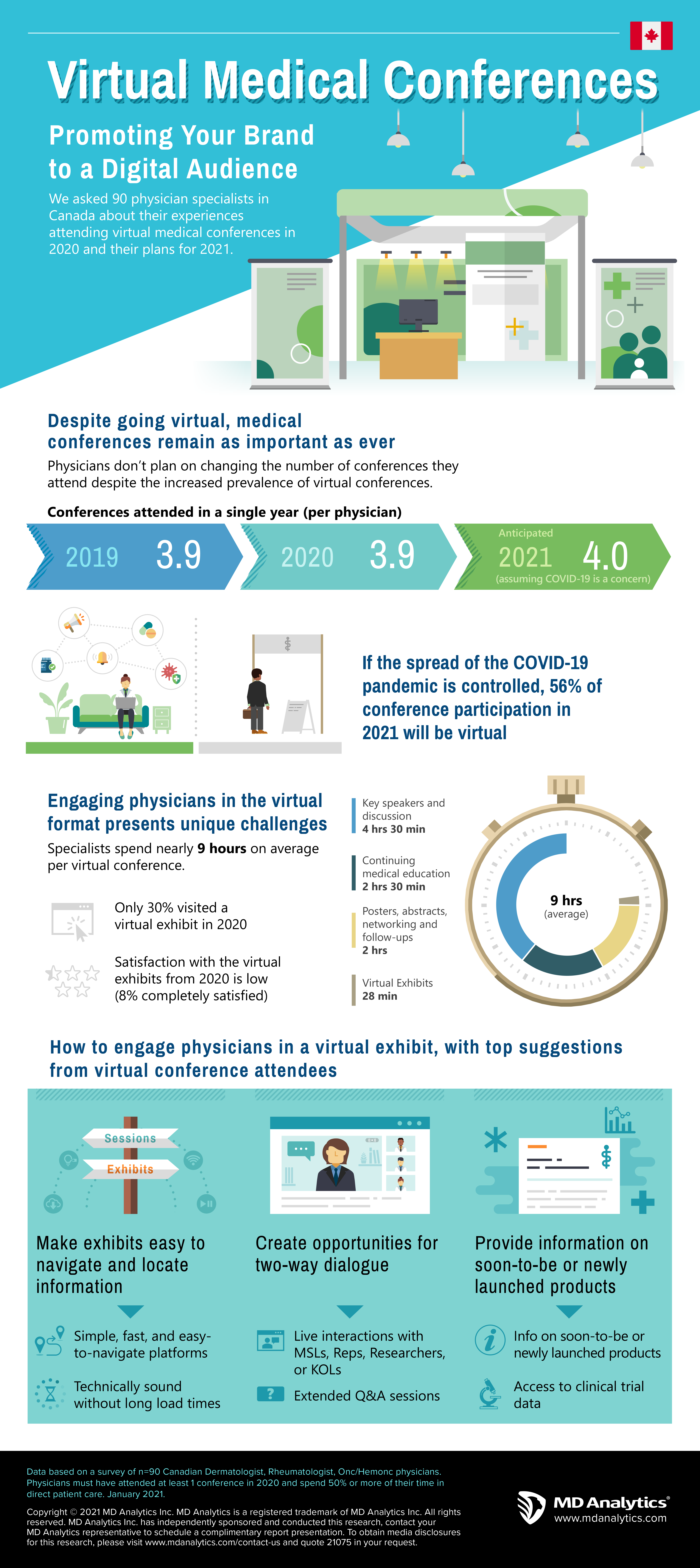Virtual medical conferences are on the rise, but are they here to stay?
As a result of the pandemic over the past year, conference organizers and medical brands were set scrambling to find a solution to limit cancelations of key medical conferences. Resulting virtual platforms advanced quickly to emulate the face-to-face conference experience through a digital means. Many virtual medical conferences were successful, in terms of strong participation levels to many key events both national and international. However, questions remained as to how well they met the needs of physicians, other healthcare providers and the pharmaceutical and medical device companies sponsoring these events. Furthermore, many exhibitors and conference organizers alike wondered if attendees would continue to embrace the virtual conference format once the impact of the pandemic subsided.
Read More
MD Analytics sought to answer some of these questions by conducting an online survey of 90 medical specialists across Canada, gauging their reaction to 2020’s virtual medical conferences and their plans for attending major 2021 events.
We found, that in 2020, Canadian physicians reported similar conference attendance levels, despite a near universal shift towards digital participation. Furthermore, 98% of physicians who attended a virtual conference in 2020, expect to attend at least one in 2021. While attendance of conferences remains steady, the overall time physicians spend engaging with content has dropped significantly. Physicians would previously spend 3 or more days engrossed in conference activities while onsite. Now they are spending just 8 – 12 hours total, even for the most prominent events.
As part of their overall attendance of virtual medical conferences, actual time spent on attending virtual exhibits sponsored by pharmaceutical and medical device companies was relatively low, with conference attendees averaging less than 30 minutes participating in these exhibits. This certainly presents an important challenge for conference organizers that often rely quite heavily on the significant revenues generated by exhibitors, and therefore highlights a clear need to improve the overall virtual exhibit experience and related participation levels. To help in this area, we also dug into physicians’ opinions on what was done well for these virtual exhibits, and where improvements could deliver a better experience. Some key considerations offered by physicians in these areas, include making virtual exhibits easier to navigate, offering more opportunities for two-way dialogue and providing information on clinical trial data or newly launched products.
Moving forward, with the COVID-19 vaccination program gaining steam in the last few months, a yearned return to normalcy will occur. The medical conference landscape, however, could forever be changed. While booming expos and extravagant booths begin to make their return, their new digital cousins will likely remain as a key consideration for anyone looking to capture physician’s attentions.
Key takeaways
- What are the top opportunities for engaging physicians with virtual exhibits?
- Where are virtual exhibits falling short of in-person conference activities?
- How has the switch to virtual conferences altered physicians’ information consumption habits?
- Which conferences are physicians most likely to attend digitally versus in-person in 2021?
Past Studies
Patient-Powered Health: Embracing Technology Solutions
The Rise of Involved Healthcare Consumers
Patient-doctor relationships have historically been very hierarchical with doctors being the experts and patients heeding their advice. In more recent years, cultural...
What Digital Media do Physicians Use?
The importance being placed on digital media by pharma and med tech/device manufacturers has grown over the past few years as it has become apparent that relying on the...
Past Studies
Gen Pop experience with Vaccines
Patient-Powered Health: Embracing Technology Solutions
The Rise of Involved Healthcare Consumers
Patient-doctor relationships have historically been very hierarchical with doctors being the experts and patients heeding their advice. In more recent years, cultural...
What Digital Media do Physicians Use?
The importance being placed on digital media by pharma and med tech/device manufacturers has grown over the past few years as it has become apparent that relying on the...

